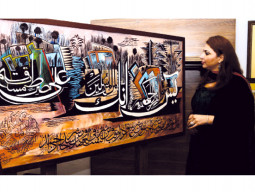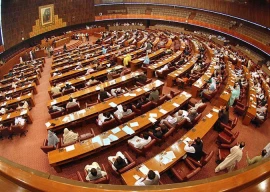
KARACHI: Exploring her experience of different mother tongues within the three generations of women in her family, artist Zineb Sedira has put up her works in Karachi.
For Sedira, three women and three languages — Arabic, French and English — also represent the past and present socio-political relationship between three countries —Algeria, France and England. The issue of displacement and mobility remains one of the primary themes in her work — emblematic of her displacement from Paris to London in the mid 1980s, and also of her parents’ immigration from Algeria to France in the early 1960s.

At the VM Art Gallery on Friday evening, Sedira’s video work, ‘Mother Tongue’, depicted the journey of three generations of the artist’s family, each communicating in their own mother tongue, however, not directly through words.
“Even a lack of communication is a way of conveying a message,” explains Sedira, adding that her mother never learned French properly because she wanted to show her rejection of the language and the attitude after the War of Independence. Sedira adds that, irrespective of that fact, her parents lived in France for economic reasons.
Her work is a part of an exhibition of contemporary art, titled ‘Homelands: A 21st century story of home, away, and all the places in between’, by an Indian curator, Latika Gupta — a doctoral candidate in art history from Jawaharlal Nehru University in Delhi.
Featuring 20 of Britain’s leading contemporary artists, the show has made a short stop in Karachi till November 20, after travelling through four Indian cities —Delhi, Kolkata, Mumbai and Bangalore — in collaboration with The British Council.
Gupta attempted to explore the meaning of belonging and alienation, of the real and imagined home, drawing from the reserves of the British Council collections of over 8,500 modern and contemporary artworks. In an era of displacement and hyphenated identities, ‘Homelands’ successfully raises fundamental questions about a world that is transforming and about the bewildering identity crisis that, for many of us, constitutes modern life.
One of the manifestations of this transformation and crisis was depicted in Nathan Coley’s artwork, titled ‘Camouflage Bayrakli Mosque’, through painted hardboard and mirror. The work reflected the chequered and contested history of the edifice built during the Turkish occupation of Belgrade in the late 16th century. The mosque was later converted into a Catholic church under Austrian rule and then reverted back to a mosque. Later, it was damaged in 2004 in retaliation against the burning of Orthodox churches in Kosovo. The mosque today is the only one in use after the Balkan war.
Despite the inclusion of other forms of arts, the medium of the show leaned predominantly towards photography, generating compelling imageries.
For instance, photographer, Suki Dhanda, follows Shopna, a young Bangladeshi-British girl, through her striking images. In order to explore the nuances of public and private lives of Muslims in the UK, the photographs showed her with her family and friends in shops, fast food outlets and youth clubs as well as in more domestic settings.
Though all the works displayed at the exhibition belonged to British artists, they emanated a deeper meaning of cross-cultural understanding. Andrea Rose, the visual arts director at the British Council, sees ‘Britishness’ as an increasingly fluid concept, with the capital city, London, home to 300 different nationalities.
The most striking feature is the first-time assortment of British art by the Indian curator, points out Sumbul Khan, the arts director at The British Council, Pakistan. “United Kingdom, India and Pakistan have a history of migration and displacement,” she told The Express Tribune. “From that point of view, it was really important to have this show in Pakistan as well.”
Published in The Express Tribune, November 4th,2013.




























































COMMENTS
Comments are moderated and generally will be posted if they are on-topic and not abusive.
For more information, please see our Comments FAQ